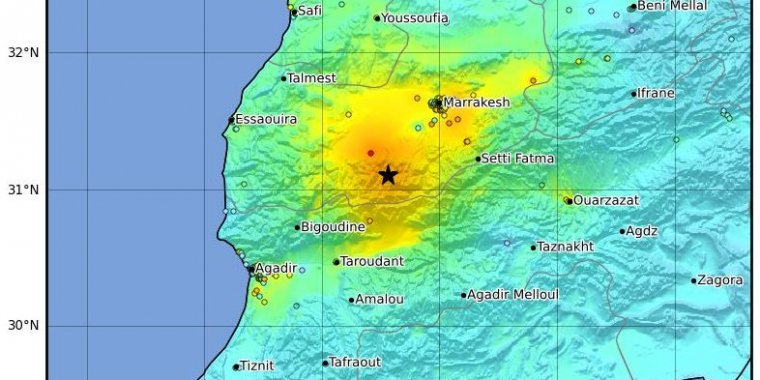| News / World News |
Marrakesh-Safi earthquake
A Mww 6.8 earthquake struck the Marrakesh-Safi region of Morocco on 8 September 2023 at 22:11 UTC. The earthquake had an epicenter located 71.8 km (44.6 mi) southwest of Marrakesh, near the town of Ighil in the Atlas Mountains.

Strong ground motion map illustrates shaking intensity. Photo: USGS
The earthquake is the largest instrumentally recorded in Morocco's modern history, only being surpassed by upper estimates of the 1755 Meknes earthquake, at Mw 6.5–7.0.
It occurred at 18.5 km (11.5 mi) depth, per the United States Geological Survey (USGS), while Morocco’s seismic agency reported a focal depth of 8 km (5.0 mi) and a magnitude of 7.2.
According to the European-Mediterranean Seismological Centre, it was also felt in Portugal, Spain, Mauritania, Algeria, Western Sahara and along the coast of the Strait of Gibraltar.
Witnesses said the shaking lasted for about 20 seconds. A magnitude 4.9 aftershock occurred 19 minutes after the mainshock.
According to state-run television, citing the Moroccan Interior Ministry, at least 1000 people were killed and 1200 others were injured.
Many fatalities occurred in remote locations south of Marrakesh.
In Moulay Brahim, residents became trapped under collapsed buildings and volunteers made rescue attempts.
Some homes in older parts of Marrakesh and portions of the city walls collapsed, leaving families trapped beneath debris.
At Jemaa el-Fnaa, a minaret of the Kharboush Mosque and parts of its walls collapsed, crushing vehicles below.
The Koutoubia Mosque was also reportedly damaged.
Several buildings in the Medina of Marrakesh, a UNESCO World Heritage Site dating from the 12th century, also collapsed.
Operations at Marrakesh Airport remained normal. (Wikipedia)
YOU MAY ALSO LIKE





